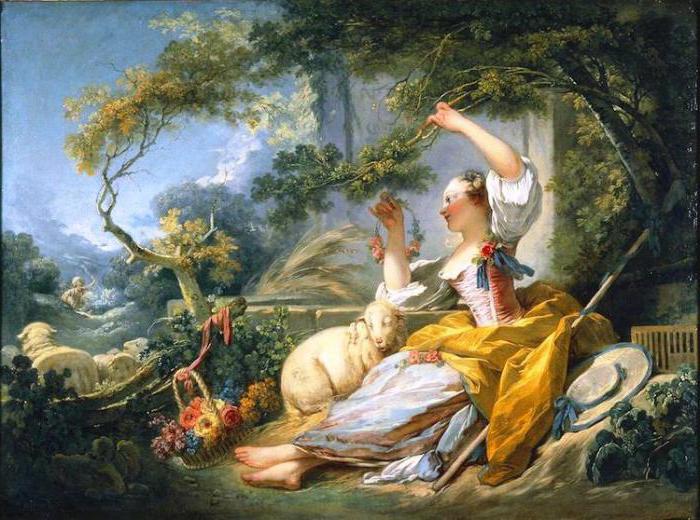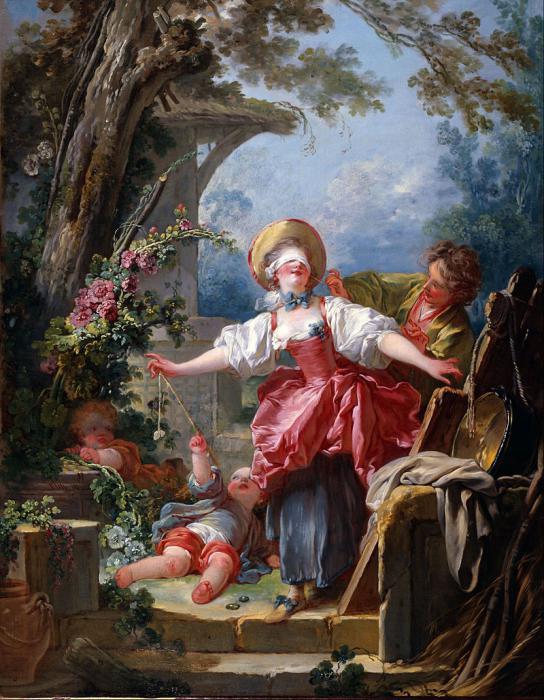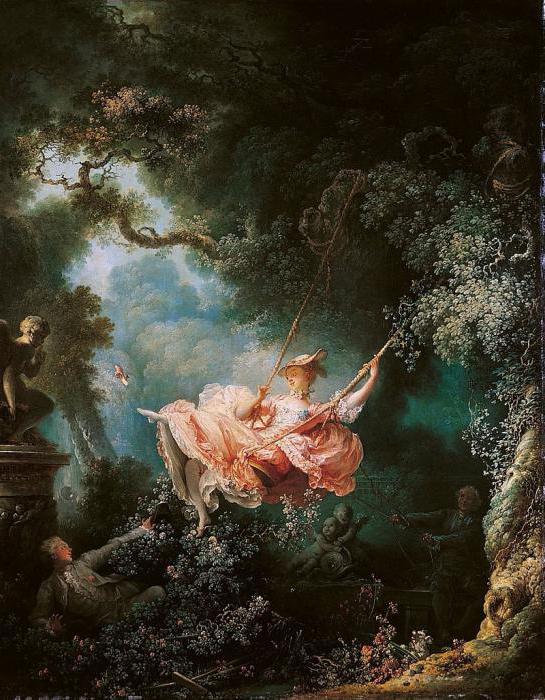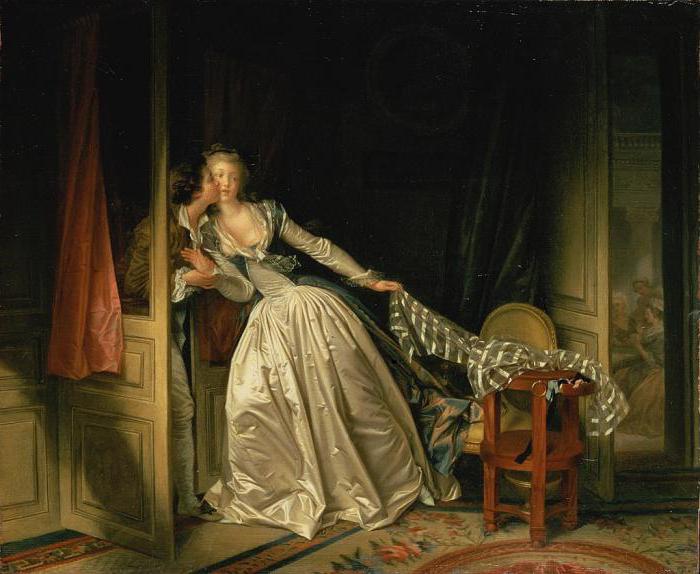Jean-Honore Fragonard (1732-1806) - painter and engraver of the sensual and refined, epicurean in its atmosphere of the Rococo period. First of all, he is a master of the pastoral and gallant genre in all its countless manifestations. We will try to present his most famous and expressive works. We begin, however, with a brief biography of the artist Fragonard.
Life path of a student J.-B. Chardin and F. Boucher
Jean-Honore was born in sunny Provence, in the city of Grasse. His father sewed gloves, but went broke, and the family moved to Paris in search of a better life. As a teenager, a boy is given to study at a notary public. But the desire to become an artist, having changed his life drastically, was so great that he ends up in the workshop of a recognized master, François Boucher. Jean-Honore’s skills are small, and after six months he goes on an internship with Chardin, and then returns to Bush. Jean-Honore learns by copying the work of a teacher. It becomes impossible to distinguish them from Boucher’s paintings. The artist Fragonard is gradually being formed, depicting young charming villages with babies, wheelbarrows of flowers, lambs. An example is the painting “Shepherdess” (1752).

The corsage of the dress is low cut, the upper skirt is matched. Her lines are whimsical, meandering. The girl with beautiful handles holds a branch of a tree and a wreath. Nearby is a basket filled with bright flowers, and a pretty little white sheep. A festive and
joyful mood pours from the picture of Fragonard. There was a great demand for such works. But the artist Fragonard did not stop there. He copied the works of old masters, becoming more and more fascinated by Rembrandt, and later by Rubens. As a result, after one of his paintings on a historical theme, he received a gold medal at the Academy and was sent to Rome. In Italy, the painter came under the influence of Tiepolo.
Return to Paris
Returning to his homeland, the artist Fragonard completely abandoned religious and classical themes, devoting his work to scenes of love, play, voluptuousness. It is with them that his name is now associated. It is enough to bring some pictures with the names of the artist Fragonard: “The Kiss Won”, “Cupid Abduction by Cupid”, “Desired Moment”, “Love as Recklessness”, “Playing with Fire”, “Guardian of Love”, “Bathers of Love”, “Fountain of Love” , “Happy lovers”, “Latch”, “Love daydreaming”. This is not all that is written by the master. After all, he has more than 500 works! Isn't that interesting!
Traits of the artist's art
Creativity Fragonard has many faces, changeable. He worked in almost all genres with amazing artistry and skill: he painted in oil, painted with bistre, sanguine, pencil, ink, and watercolor. The technique of etching was also subject to him. Throughout his career, he was influenced by different artists and wrote in different manners. But the works of Honore Fragonard are always recognizable: almost all the gallant-erotic motifs of the 18th century are represented in his painting - passionate love hugs and a playful game, genre love scenes and naked bathers, which are more reminiscent of marine naiads. The everyday episode of the artist's choice of nature becomes, under the brush of Jean-Honore, piquant, playful (“The Artist and His Model”). The lightness of images and plots is smoothed out by the power of pictorial talent and filled with poetry. The paintings of Fragonard enchant with the captivating beauty of life, sincerity, purity and freshness of feeling. For example, "The game of blind man's eyes" (1769, Toledo).

The richness of its palette lies, in short, in pure-color strokes (wide, flowing or sharp, short), which are combined with mixed color. This will later delight the impressionists. And the last thing to say. Fragonard saturated all his works with light. In the shadows, the
colors thicken almost to black or begin to shine in pearly white, pink or golden hues. Light gently flows around all forms and fills the space, creating a mascara characteristic of the artist.
Piquant plot
By order in 1762, the painting "Swing" was painted. Jean-Honore Fragonard is associated with most admirers of his works with this particular work.

Lush and lushly swirling tall trees and shrubs of the park fill the area of the work. They “harden” in the foreground into beautifully painted leaves and flowers. The rest of the environment is immersed in a greenish brown twilight. The sun penetrates him, illuminating the blue sky, against the background of which the young lady, like a graceful air butterfly, took off on a swing with a red velvet seat. She knows that the one who swings her from behind does not see the second young man who hid in the bushes. He is very young and gracefully mannered. The coquette with pleasure does not hold magnificent coral pink skirts. They rise high and open the delightful gaze of the charming legs, which the beauty gladly gives to admire. With playfulness, she throws the shoe into the air, as if giving it to a secret admirer. Three characters of the gallant scene are innocent-sensual and a little naive. These qualities make them part of the natural environment. Amur Falcone, standing on a pedestal, craftyly presses a finger to his lips, urging everyone to only silently admire the gallant scene. The picture is easy to perceive, since it combines the material beauty of life and theatrical entertainment. The whole composition is turned by the author from a joke into a picturesque poem.
70s park cycle
As a true son of his time, the artist loved park art and with inspiration he painted trees with a huge radiant sky and melting clouds. Their enormous size served as a contrast to small figures of people. Many paintings by Jean Fragonard can serve as an example: “An elegant company landing in the park”, “Island of love”, “The flowering of love: love letters”, “Holiday in Saint Cloud”, “The flowering of love: the pursuit”. In particular, we will offer a look at the "Small Park".
The master introduced into the perception of nature a shade of entertainment, softness, intimacy, sophistication. He looks at the structurally organized nature from the side. In the melting mass of trees and clouds, light and color form a single whole, embodying the material world in a poetic work. The park cycle is the pinnacle and epilogue of a gallantly festive theme in the work of the master.
Singer of the family hearth
In the spirit of the Age of Enlightenment, under the influence of Didro and Rousseau, Fragonard begins to write scenes of family life. He looks intently at the young girls and young mothers of the family. They are on the paintings of Honore Fragonard full of enthusiasm and fun. The former sensual charm is felt in them: “Cooking dinner”, “Caring mother”, “Happy family”. Scenes with children were written with a special, picturesque splendor of humor and tenderness: “The Boy with the Curiosity”, “Tell me Please.” Genesis in the art of Fragonard is poeticized and dramatized.
Portraits
This is one of the vast areas in which the master worked all his life. His works are not filled with psychological characteristics, but serve to decorate salons. It seems that his models do not pose, only for a moment they turn their faces to the viewer. Usually these are people familiar to the author: writers, artists, artists, their daughters. The names of the paintings speak of their generalized image: “Memories”, “Inspiration”, “Music”, “Singing”, “Reading”, “Philosopher”. A picturesque composition is usually based on the contrast of dark, thickened colors and clothing and radiant, light tones of the head. Let's look at a few portraits.
Pensive Reading Girls
Dreamy-romantic and lyrical notes begin to appear in these images. The portrait of “Reading Girl” was for some time considered the most popular work of the master.
He painted a cozy sitting girl, completely carried away by reading the novel. She is focused, and nothing takes her from an interesting book. This is the most ordinary occupation, the artist filled with poetry of everyday life and bright decorativeness. The character captivates with a fresh young face with delicate peach skin. Her dress is light lemon in color with a white collar and cuffs reflecting
sun glare. The girl sits leaning against a soft pillow of lilac color, on which shadows of a deep golden-purple color fall. This portrait was painted during the transition period, when Fragonard was already moving away from typical Rococo images.
"Love letter"
This painting by the master is in the Metropolitan Museum of Art and was painted around 1770.
The young beauty in a pearl-silver dress, depicted by light air strokes, and with a little white lapel behind her, sits at a table by the window. She was taken by surprise, turned her face from the sheets lying on the table to the one who suddenly entered the room. In her hands is a bouquet with a note enclosed in it. The joy that all her fragile figure radiates, a slight smile and pink cheeks shows that she was waiting for this note. She is now quite happy, knowing that she is loved. The rays of sunlight that slip through the window, color her skin with golden hues, also play on the golden drapery of the walls and the brown polished table. The beauty of the portrait is that it does not seem to be a production, but a moment taken from life.
Search for new directions in painting
In the 80s and 90s, the artist feels how the style of painting is changing. It becomes dry, strict. David sets a new direction - neoclassicism. Heroic production scenes expressing the desire for freedom and the chased bas-relief of the image are becoming popular. Fragonard, not fully accepting the latest research, turns his attention to the "small Dutch". Their influence can be seen in the work presented below.
"Sneak a kiss"
Consider one masterpiece of 1788, which is located in the Hermitage. This later work of the master came to Russia in 1895 from the collection of S.A. Poniatowski as an exchange for the painting "Polka". The genre scene, invented by Fragonard, as if he had been seen in life.

The girl left the living room, filled with visitors, to take the scarf she had forgotten. Oops! And she has already been caught by a young man who can no longer tolerate without breaking a kiss from a beautiful woman. He is not at all bothered by the guests who are visible through the half-open door. The main thing is that the goal has been achieved. The young man gently but firmly holds the subject of his passion. She is shy and cautious that they will be seen, obeys the cavalier, trying not to get too close to him. The girl is in awe and is ready to run away at the slightest opportunity. We will not dwell on the coloristic prowess and style, which was influenced by the incoming classicism. This can be seen without words in the presented reproduction.
Departure from Paris
During the revolution, the artist Fragonard leaves Paris from the seething and terrible. His patrons and customers were guillotined or expelled. The painter found shelter in Grasse with his cousin Alexander Molbert. Only at the beginning of the 19th century did the artist return to the capital. Busted and forgotten by all, he dies in 1806.
The value of the artist Fragonard, interesting facts
The painter was able to organically combine theatricality and realism in his images, incomparable sophistication and energy, almost ethereal dreams and dreams and the sensual fullness of life. He summed up all the directions that existed in the XVIII century, and became the forerunner of classicism, romanticism and realism of the next century. Rediscovered, he again began to give people la joie de vivre.
- The Impressionists honored him as one of their teachers and forerunners.
- The artist wrote unusually fast. On the backs of his portraits you can find inscriptions that the work was written within an hour.
- Sales of his painting “Portrait of Francois-Henri, Duke of D'Arcourt” at world auctions in 2013 reached a record point of $ 28 million.
- The museum in Paris, as well as the factories and the perfume museum in Eze and Grasse, are named after the master.